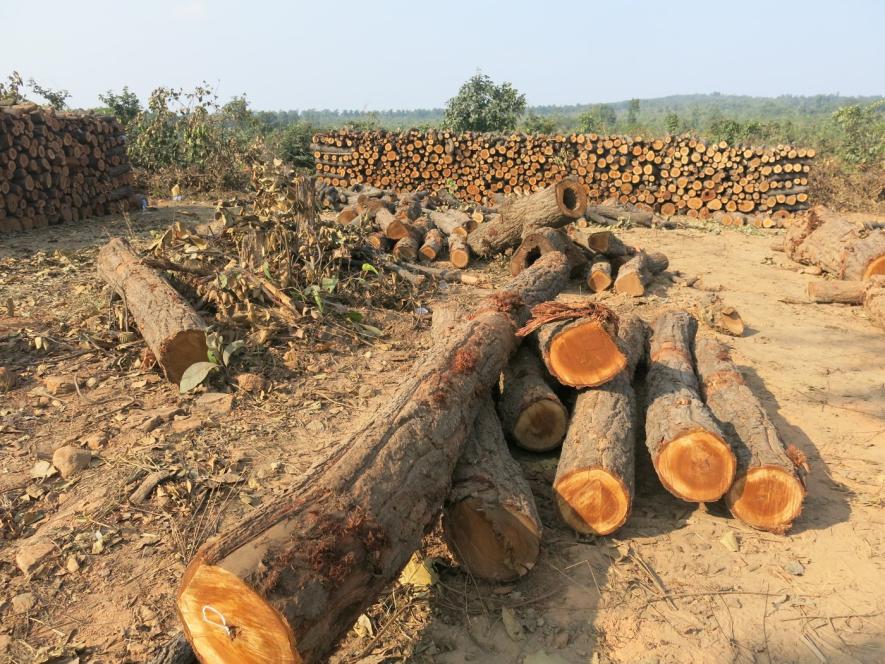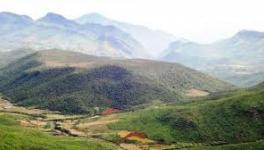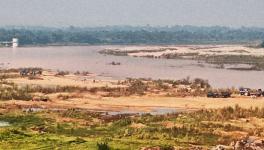Cities Need to Beat the Heat: India Should Place Moratorium on Cutting Trees

Image Credit: People's Archive of Rural India.
Delhi was scorching through May crossing 50 degrees Celsius in the month-end. There has been some controversy regarding the functioning of an IMD sensor in Mungeshwar (Delhi) but there is little doubt that our cities are touching unparalleled highs. Why is this happening. The answer is very simple.
Our cities have become gigantic urban sprawls whose natural tree cover and other foliage has been stripped away to make way for multi-storeyed complexes that cut off natural wind flows. They have become networks of cemented highways and asphalt parking lots with million cars and 50 times the number of ACs (air-conditioners) and exhausts spewing out hot air that have helped create gigantic urban ovens that absorb heat during the day and radiate it back into the atmosphere at night. This heat island effect is known to increase urban temperatures by as much as 15 degrees C compared with rural areas.
Lutyens Delhi may have some tree cover left but by and large, for the 20 million residents struggling to cope with this extra heat, life has become a nightmare.
There are no accurate figures available on the number of deaths due to this intense heat but the figure could well be running into hundreds. Many cities are recording all-time high temperatures. Chandigarh’s temperature reached 46.7 degree C as did Dehra Dun, where temperatures touched an all-time high of 44 degrees C.
Many explanations have been offered for this heat. There is no doubt that climate change has accelerated extreme weather events. The warming of the Arabian Sea by 1.2 to 1.4 degree C is causing warm winds to blow into the Indian land mass. This has combined with hot winds blowing in from the Arabian Peninsula in West Asia toward Rajasthan and north west India, pushing temperatures even higher.
The El Nino climatic phenomenon is another factor that is often cited as a reason for record-breaking temperatures on land and in the oceans. But the current El Nino event that began in July 2023, is in its waning phase with a good possibility of a La Nina event, which generally cools down global temperatures a few months from now.
The India Meteorological Department or IMD states that a heat wave condition prevails when the temperature rises to 40 degrees C. A 13 degree jump, as has happened in Delhi, makes it a super scorcher. Is this a presage for worse times in the future?
Experts insist that unless adaptive steps are taken immediately to mitigate the situation, things will only get worse with temperatures going as high as 55 degrees C. Environmentalists have been issuing warning after warning on this score, emphasising that trees are the most cost-effective way to reduce urban heat. Trees do not just provide shade. Water evaporating from their leaves can cool a neighbourhood by a few degrees during the hottest period of the day. Tree leaves also absorb and filter local air pollution which is another endemic problem that our cities are now facing.
Yet we are doing the exact opposite. Government data affirms that over 100 hectares of precious forest land in Delhi has been diverted in the past 15 years for building roads and transmission lines.
During the same period (2009-2023), we have diverted three lakh hectares of forest land for non- forest purposes knowing full well that all that hoopla of compensatory afforestation does not work. In 2020-21, about 30 lakh trees were cut for infrastructure projects while a recent Danish Nature Sustainability study confirmed that India had lost six million fully grown trees (read cut) from our farm lands.
Millions of trees that provided an ecosystem of support and nourishment and beauty hacked away to fulfil this fantasy of `development’. Take the example of the government pushing for a new Delhi-Saharanpur- Dehra Dun Express highway (when a new one via Meerut was completed a year ago) that will reduce driving time by an hour. This highway will involve the axing of Doon’s legendary Sal trees, which scientist Dr Ravi Chopra so poignantly described as the ` soul of Uttarakhand’. Destroying these trees is akin to destroying our souls.
This Expressway will also involve a 12-km long overpass but sadly the pillars of this overbridge are being built on river beds.
The 20-kilometre stretch between Ganeshpur and Dehra Dun passes through the rich Shivalik forests. Experts emphasised repeatedly that these hills and their vegetation have protected the Doon Valley from heat, dust and pollutants, as also provide a home for its rich wildlife and biodiversity. They could just as well have been talking to a wall. The Rs 20,000 crore project has been pushed through for a city already well connected by road, rail and air transport.
A similar dangerous exercise was undertaken in Haryana where the amendment of the Punjab Land Preservation Act (PLPA) would have opened up 25,000 hectares of forest areas in the Aravalli hills for construction and mining activities.
The Aravali hills have been shielding Delhi and Gurgaon against desertification, dust storms and intense heat. Experts have warned the state government that conserving these remaining forested areas was the last chance to prevent Delhi and its neighbourhood from becoming a desert.
Sadly, illegal mining and land grab has given short shrift to these warnings and the public at large is facing the consequences.
The heat we are at present facing has been further accentuated by forest fires that have turned lush tree lined hillsides to ash along both the lower and upper Himalayas. These fires have been smouldering from last November. Instead of combatting them on a war footing, the forest department officials believed these would get extinguished by the winter rains. This did not happen as it turned out to be an unusually dry winter. The fires have now spread across both Uttarakhand and Himachal Pradesh.
The fetish for infrastructure across North and South India is resulting in rampant deforestation. None other than an august body like the NITI Aayog has warned how large-scale deforestation is having an adverse impact on our monsoon. When precipitation levels become depressed because of fewer trees, it means fewer leaves transpire water back to the atmosphere resulting in higher and drier weather conditions.
A direct concomitant of the loss of forests has been the drying up of water sources including our springs and rivers. It should come as no surprise to learn that our main reservoirs have hit their lowest levels in a decade. Data provided by the Central Water Commission highlights that water levels in our 150 reserves are down to between 14% to 20% of their capacity. A monsoon failure will result in a major water crisis.
Engineers who have pushed the Delhi-Dehra Dun Expressway, which cuts across the Shivalik Hills, seem to have overlooked the fact that this mountain range forms a key water catchment area from which several rivers emanate. These rivers include the Mohan Rao, Sukh Rao, Solai, Chillawal, Chika Rao, Binj Rao and Aderi Rao.
The Asharoddi ridge, on which this expressway is being built, is the source of over 20 rivers, including Hindon and Salori. These rivers start from here and flow to Uttar Pradesh.
The National Highways Authority of India and the Uttarakhand government have overlooked the fact that the drying up of these rivers will adversely impact the water security of western Uttar Pradesh. The widening of the Char Dham project is having an equally disastrous effect on the Mandakini, Alaknanada and Bhagirathi and Yamunotri rivers which form part of the upper catchment of the Ganges and Yamuna rivers.
And this seems to be the case with many of our massive highway projects that are being hurriedly pushed through without studying their consequences.
We are overlooking the fact that India is one of the most water stressed regions in the world. The 2019 NITI Aayog report indicated that 600 million Indian are facing high to extreme water stress and the situation will only get worse.
During summer, it is water bodies and trees that have been found to be essential to provide immediate relief and it is both these entities that we are doing away at a time when climate change is causing global warming.
Extreme heat results in a range of illnesses and death. These include heat stroke and hyperthermia. In India, most of our working population work on farms or on the streets where trees alone can provide them with some relief.
Many cities in the world are having to cope with this problem. The solutions they have found are local in nature. Some Western countries are now experimenting with `pocket forests ‘across their cities which will also act as `climate shelters’. Parks and water fountains are being provided for and roof tops are being planted with vegetation.
In India, we can start by placing a moratorium on the cutting of trees. We can also stop the excessive concretisation of our cities, much of which is builder/politician-driven, and work instead toward greening our cities. This is the most cost- effective way to beat the heat.
The writer is an independent journalist. The views are personal.
Get the latest reports & analysis with people's perspective on Protests, movements & deep analytical videos, discussions of the current affairs in your Telegram app. Subscribe to NewsClick's Telegram channel & get Real-Time updates on stories, as they get published on our website.























